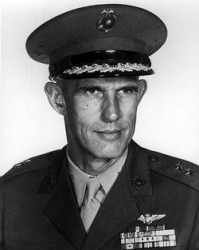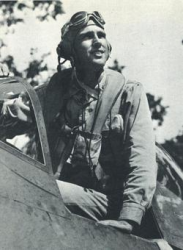
 |
|
|
||
|
Marion Eugene Carl |
||||
|
Engagements: • World War II (1941 - 1945)• Vietnam War (1960 - 1973) |
||||
| Biography: | ||||
|
Marion Eugene Carl Marion Eugene Carl was born on 1 November 1915 on the family farm near Hubbard, OR. Carl was always attracted to aviation. He learned to fly while attending college and soloed after only 2½ hours of instruction. (Eight to ten hours is typical.) He studied engineering at Oregon State College (now a university) and, upon graduation in 1938, was commissioned as a Second Lieutenant in the U.S. Army Reserve. Military Service Carl resigned his Army commission to become a Naval Aviation Cadet and, in December 1939, received a commission as a Second Lieutenant in the Marine Corps and was designated a Naval Aviator with "wings of gold." Carl's first posting was to Marine Fighting Squadron One (VMF-1) at Quantico, VA, which lasted for one year. Ordered back to Pensacola, Carl served as an Instructor Pilot helping to train the rapidly growing number of naval aviators. He later received orders to the newly-formed Marine Fighting Squadron 221 (VMF-221) at NAS North Island in San Diego, CA. World War II The 7 December 1941 attack on Pearl Harbor found VMF-221 preparing to embark aboard the USS Saratoga for transport to Marine Corps Air Station Ewa on the island of Oahu, HI. Carl, along with the rest of VMF-221, was hurriedly rushed to Hawaii and then included in the Wake Island Relief Task Force, still aboard the Saratoga. After the relief attempt was canceled, VMF-221 was deployed to Midway Atoll on Christmas Day 1941. Carl's first combat occurred six months later during the Battle of Midway on 4 June 1942, when 15 of the 25 aircraft VMF-221 put into the air that morning were destroyed. Nevertheless, Carl was credited with destroying one enemy aircraft, a Mitsubishi Zero and was one of only two pilots that were able to get airborne later that same day when it was thought a second attack was occurring, although that turned out to be a false alarm. Along with the other survivors from VMF-221, Carl was flown back to Hawaii shortly after the battle. Granted a very short rest period, Carl was reassigned to Marine Fighting Squadron 223 (VMF-223) commanded by a former squadron mate from VMF-221, Captain John L. Smith. On 20 August VMF-223 was deployed to Guadalcanal, the first fighter unit ashore with the Cactus Air Force. Over the next two months he became the Marines' first ace, running his tally to 16.5 victories, though he was shot down once and was forced to bail out. It is believed it was Marion Carl who shot down the famous Japanese Navy Tainan Kokutai ace Junichi Sasai over Henderson Field. In 1943, then Major Carl returned to the Pacific and led VMF-223 until the following summer. During additional combat in the Solomon Islands he claimed two more enemy planes, finishing as the Corps' seventh ranking ace with 18.5 victories. Test Pilot In 1945, Carl graduated in the first test pilot class at Naval Air Station Patuxent River, MD. As a Lieutenant Colonel, he conducted pioneering jet operations from aircraft carriers and later commanded VMF-122, the first Marine jet squadron. He was also the first Marine to pilot a helicopter. In 1947, Carl was one of two pilots selected to fly the Douglas D-558/I Skystreak in record setting speed attempts. That August, he was recorded at 650 mph, establishing a new world record. When Air Force Captain Chuck Yeager broke the sound barrier in October, he also broke Carl's record. At Patuxent River on 1 April 1952, Carl had a close brush with death. He was performing a series of check spins in the new Grumman AF-2S Guardian anti-submarine attack aircraft. The anti-spin parachute that had been fitted in earlier tests had been removed. Climbing to 10,000 feet over Chesapeake Bay, Carl commenced the spin. The aircraft entered a flat spin with strong centrifugal forces. Carl could not break the spin and rode it down to 4,000 feet. He tried to operate the ejection seat but the face blind ripped away in his hands and the seat failed to fire. He climbed out at 3,000 feet. He then tried the wind-tunnel approved method of getting out on the inside of the spin but was forced back due to airflow. He finally got out on the other side and felt his parachute open as he fell into the splash of the aircraft. The success of this proved bailing out on the inside of the spin to avoid being hit by the tail was an incorrect theory. His chase plane stayed with him until a flying boat could recover him. During a second test pilot tour in 1953, Carl set an unofficial altitude record of 83,000 feet in the Douglas D-558/II. Between test pilot duties, Carl commanded other units including a reconnaissance squadron based on Taiwan. In 1954, he led missions over Mainland China, photographing Communist forces along the coast. After his death, a corrupted version of his reconnaissance missions appeared in several obituaries, stating that he had flown U-2 spy planes. Vietnam War Though still a Colonel, Carl became Director of Marine Corps Aviation for five months in 1962. Two years later he was promoted to Brigadier General and, in 1965, he took the First Marine Brigade to Danang, South Vietnam. Despite his seniority, he repeatedly flew combat missions in helicopter gunships and jet fighters. Carl received his second star as a Major General in 1967, commanding the 2nd Marine Aircraft Wing at MCAS Cherry Point, NC, from 1968-70. Subsequently he served as Inspector General of the Marine Corps. Carl retired from the Marine Corps in 1973 and, at that time, he had logged some 13,000 flying hours; more than twice as many as most contemporaries. Medals and Awards Navy Cross (2 Awards) Badges Naval Aviator Badge Carl declined any personal medals or awards for his service in Vietnam. Honors In 1992, he was inducted into the Lancaster, CA, Aerospace Walk of Honor. On 21 July 2001, Carl was enshrined at Dayton, Ohio, in the National Aviation Hall of Fame Class of 2001, along with North American X-15 pilot Joe Engle, USAF ace Robin Olds, and Albert Ueltschi. Roseburg Regional Airport, in Roseburg, Oregon, was named the Marion E. Carl Memorial Field in honor of Carl. MATSG-23 holds an annual "Mud Run" in honor of Carl at Naval Air Station, Lemoore, CA. The 5-mile run includes mud pits, climbing walls, and other military obstacles to challenge the runners. The airfield at Marine Corps Air Station Kaneohe Bay was named for Carl. In Retirement After retiring from the Corps, Carl returned to his native Oregon, where he and his wife Edna settled near Roseburg. Marion Carl's memoir, Pushing the Envelope, coauthored with his friend Barrett Tillman, was published in 1994. Death and Burial On 28 June 1998, at age 82, Major General Marion Eugene Carl was shot to death with a shotgun during a robbery, while defending Edna from a home invader. Carl is buried at Arlington National Cemetery in Arlington, VA. Carl's killer, 19-year old Jesse Fanus, received the death penalty for murder. |
||||
| Honoree ID: 2312 | Created by: MHOH | |||
Ribbons
Medals
Badges
Honoree Photos
 |  |  |
 |  |
 |


